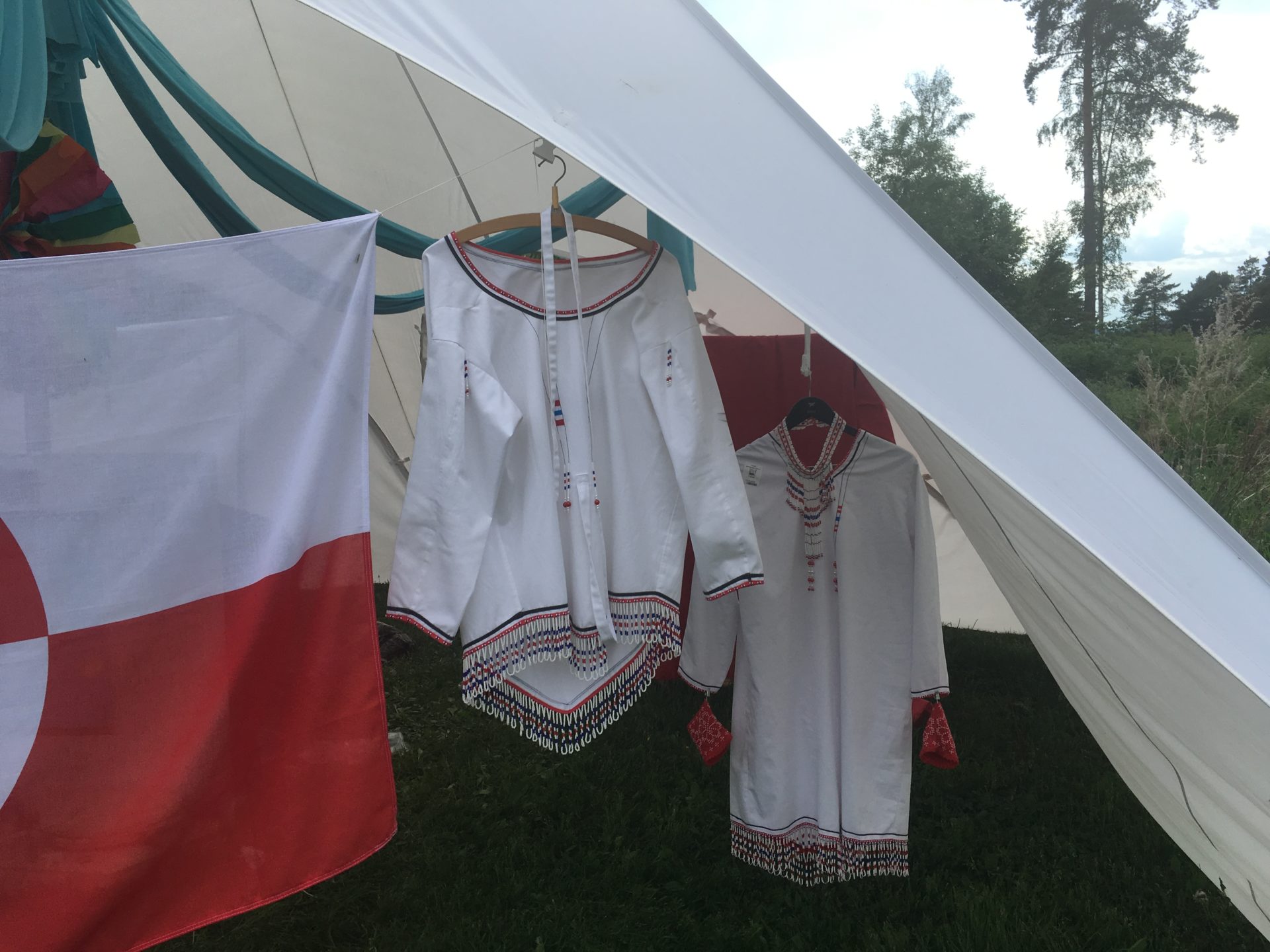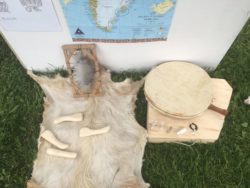Reflection on ETHER Seminar One: Location, location, location

by Ingrid Rodrick Beiler (Oslo Metropolitan University) and Joke Dewilde (University of Oslo)
During the first ETHER seminar, Adam Jaffer and Thea Pitman talked about their fascinating work with different communities to create inclusive exhibitions. Their provocations and the following conversations reminded us about the complexities of representation – when representing others and oneself – and the significance of space and place for representation.
Location, location, location: Representing Difference in Regional Centres
Both Jaffer’s and Pitman’s presentations raised questions about balancing different interests when creating a space for minoritised communities’ stories in the halls of a traditional museum. One issue that their presentations got us thinking about was the significance of space and place for representation. In sociolinguistics and geography, a distinction is often made between space and place, where space is seen as more open and malleable, whereas a place is space to which we attribute certain characteristics such as belonging or property rights (Blommaert, 2005; Milani et al., 2017). While social agents delimit and define meaningful spaces, Miller (2012) suggests that spaces also exercise influence on people who pass through these spaces. She refers to this as “the agency of spaces” (Miller, 2012, p. 441).
Budgets, Travel, and Institutional Rules
In his presentation, Jaffer referred to the significance of working in a particular place, Leeds, for his possibilities to represent various cultures. Specifically, he noted that a limitation of a small museum is the inability to have direct contact with all of the communities represented in exhibitions. While some communities have members who live in or near Leeds, others, such as Pacific Islanders, are not well-represented in the museum’s environs, and the museum does not have the budget that a large museum such as the British Museum would have to bring people to self-represent as part of exhibitions. Thus, curators such as Jaffer are given additional responsibility for representing others. The discussion raised many important themes such as how to engage communities in self-representation – even when they are on the other side of the world – and how financial resources influence what is possible.
In contrast, Pitman’s presentation related to the experience of an indigenous community entering museum halls to represent their own culture, in this case in Brazil. Pitman reflected both on how the indigenous participants exercised agency in expanding or even flouting certain institutional rules, but she also noted some limits on the participants’ ability to negotiate the space. For instance, they were not able to stay in the museum overnight, although they did manage to use the exhibit as a space for selling crafts, both of which contravened the museums’ guidelines. Thus, both the museum space and the indigenous participants brought their agency to bear on the event.

We wondered if there might be any additional significance in the space beyond the museum walls also in this location. As in Leeds, travel to the museum featured as a dimension of representation. However, in Pitman’s case, participants were able to travel to self-represent, traversing a significant distance within their own country to reach the museum. This museum was located in Salvador de Bahia, which, as far as we understand, bears some similarity to Leeds in constituting a regional centre but not a national seat of power. In representing a minoritised community that is not primarily external but indigenous, are there any similar dynamics to those in Leeds, whereby museums in the largest cities have greater financial means to regularly invite people to represent themselves in exhibits? We also wondered if indigenous communities would experience different possibilities for self-representation in different locations in their own country, how such differences might manifest, and how diversity and differentiation can be brought into the category of ‘indigenous’.
Multicultural Events as Opportunities for Self-Representation, Encounters and Other Objectives
Similarly to the discussion of museums’ ethical responsibilities when representing others, in the research literature, multicultural school and community events have been criticised for potentially promoting cultural stereotypes and essentialist ideologies. With colleagues, Joke investigated a multicultural school festival at a primary school and an international community festival in a mid-sized Norwegian town, presumed by many to be relatively culturally homogenous (Dewilde et al., 2018, 2021). Even though the team found traces of fixed and stereotypical representations of different groups, the school’s leadership and staff reported that these events provided opportunities for them to collaborate and learn from minoritised students and parents.
As both Pitman and Jaffer noted for museum exhibits, multicultural events may also constitute an arena for representation and self-representation of minoritised groups. Looking across museums and other civic and educational spaces, such sites of encounter may afford agency for minoritised groups to challenge their own reduction to being positioned as victims of a majority-dominated and non-inclusive practice. At the multicultural school festival in Joke’s study, students and teachers in year 5 made posters representing different nations present at the school. In the poster about Kurdistan, they mistakenly included a line that Kurdistan was located in Iraq, as well as a picture of an arbitrary mountain range. In contrast, a Kurdish father brought additional information sheets, dual language books in Kurdish and Norwegian and multiple cultural artefacts, which resisted essentialisation by re-telling stories of a more complex and rich reality. The space of this event created an opportunity to be encountered differently.
In addition, the international community festival invited groups from abroad to represent themselves. As part of a more comprehensive collaboration, the festival organisers travelled to Greenland to work with two groups of locals and discuss how they could represent themselves to a larger audience in Norway. According to the organisers, this had been a difficult task, as the Greenlanders had never travelled to represent themselves. The Greenlandic polka is considered a standard cultural element and common free-time activity in Greenland, and one of the groups decided to learn how to dance the polka for the sake of the festival. When performing at the festival, they seemed uncomfortable. In interviews, the group from Greenland was equally concerned with what they could learn from participating in the festival, for example how to get people to volunteer for big events or to learn to become more open to other cultures. We wondered if communities in other places have expressed similar discomfort or looked for inspiration to bring home when invited to represent themselves.
People, Spaces, and Places of Cultural Representations
In sum, we found in Jaffer’s and Pitman’s presentations fertile grounds for thinking about the interplay of people and spaces in creating cultural representations in particular places. Their presentations demonstrated the salience of budgets, the (im)possibility of travel, and institutional rules that may or may not bend to the wishes of those represented. We have added to this two examples from Joke’s research on how local and international participants prepared particular self-representations for multicultural festivals in a mid-sized town, both adapting to the festival space and seeking to achieve certain objectives within the festivals. All of these cases come from locations and institutions that represent cultural difference to people in regional centres. Perhaps these places can help us to understand possibilities for representation within the limited means and access common to many museums, festivals, and other spaces of curation.
References
Blommaert, J. (2005). Discourse: A critical introduction. Cambridge University Press.
Dewilde, J., Kjørven, O. K., Skaret, A., & Skrefsrud, T.-A. (2018). International week in a Norwegian school. A qualitative study of the participant perspective. Scandinavian Journal of Educational Research, 62(3), 474–486. https://doi.org/https://doi.org/10.1080/00313831.2017.1306800
Dewilde, J., Kjørven, O. K., & Skrefsrud, T.-A. (2021). Multicultural school festival as a creative space for identity construction – from a minority parent perspective. Intercultural Education, 32(1), 1–19. https://doi.org/10.1080/14675986.2020.1851173
Milani, T. M., Williams, Q., & Stroud, C. (2017). Space/place matters. Multilingual Margins: A Journal of Multilingualism from the Periphery, 4(1), 2–6.
Miller, E. R. (2012). Agency, language learning, and multilingual spaces. Multilingua, 31(4), 441–468. https://doi.org/10.1515/multi-2012-0R
